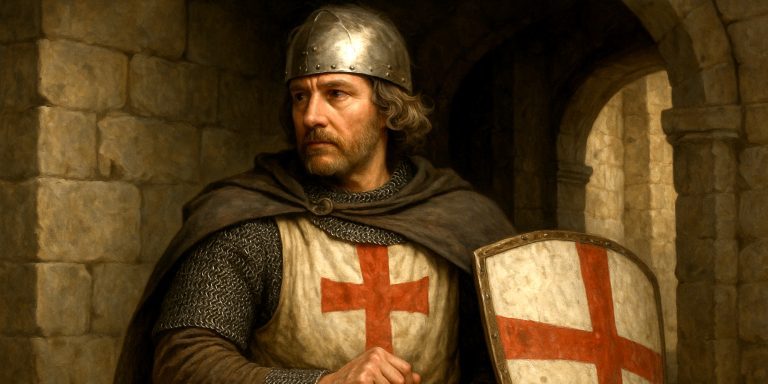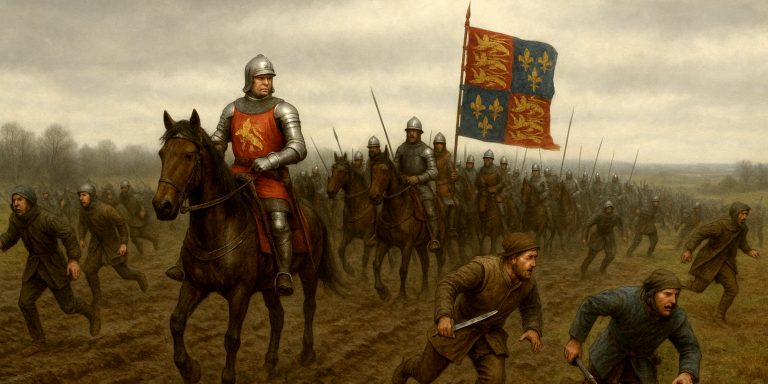
Few figures in English medieval history burn as brightly, or as controversially, as Simon de Montfort. Depending on who you ask, he was either a visionary who paved the way for parliamentary democracy or a reckless noble who pushed England into civil war. Either way, he changed the country forever.
Origins and Ambition
Born around 1208 in France, Simon de Montfort was the son of the elder Simon de Montfort, the crusader who brutally subdued the Albigensians in southern France. The younger Simon arrived in England in the 1230s to claim his family’s ancestral earldom of Leicester, which had been lost after his father’s rebellion decades earlier.
He soon found himself tangled in the politics of Henry III’s court. A capable soldier with a gift for commanding loyalty, Simon married the king’s sister, Eleanor of England, a union that brought him close to the crown but also deep into royal disputes. Ambitious, sharp-witted, and openly critical of Henry’s finances and foreign favourites, Simon’s relationship with the king shifted from uneasy friendship to open hostility.
Arms and Armour
Simon de Montfort’s military career spanned a turbulent era of transition in arms and armour. He would have worn the classic knightly mail hauberk reaching to the knees, reinforced by a padded gambeson underneath. By the 1250s, many nobles, including Montfort, were adding early forms of plate defence: metal splints sewn into leather to protect shins and forearms.
His helm would likely have been the enclosed great helm, a fearsome cylinder of steel with narrow slits for vision, paired with a surcoat emblazoned with his heraldic arms, reportedly a white lion on a red field, though variations exist in later depictions. His weapon of choice was the knightly sword, balanced for both cut and thrust, supported by a heater shield and possibly a mace for close fighting.
The army he led in the Second Barons’ War was a reflection of his disciplined approach. His forces used crossbowmen, dismounted knights, and defensive tactics that emphasised positioning over brute strength. This was not a reckless medieval warlord but a commander who thought in terms of coordination and morale.
Battles and Military Acumen
De Montfort’s military legacy hinges on two defining moments: the Battle of Lewes (1264) and the Battle of Evesham (1265).
At Lewes, he outmanoeuvred Henry III’s larger royal army through cunning and restraint. His men occupied the high ground, used the terrain to their advantage, and broke the enemy’s confidence through a controlled advance. The result was astonishing: the king and his son Edward (the future Edward I) were captured, and de Montfort effectively became England’s ruler. For over a year, he governed through a council system that included elected representatives from towns, a revolutionary step towards parliamentary representation.
But at Evesham, his brilliance could not save him. Edward escaped captivity, raised a new army, and trapped de Montfort’s forces in a disastrous ambush. In August 1265, under dark clouds and heavy rain, Simon was cut down in battle. Chroniclers described his body mutilated after death, a grim warning to all who had challenged royal power.
Yet his defeat did not erase his legacy. The very idea of barons and commoners meeting to restrain the crown survived and evolved, eventually becoming the cornerstone of English governance.
Legacy and Historical Perspective
As a historian, I find de Montfort fascinating precisely because he resists simple categorisation. He was proud, occasionally self-righteous, yet his reforms were astonishingly forward-looking. The Parliament he summoned in 1265 included not just nobles but representatives from boroughs, a step that connected political authority with the people in a way unseen before.
His rule was short, chaotic, and marred by violence, but it showed that England could be governed by consent rather than decree. That idea, half-formed, tested in battle, and paid for in blood, outlived him.
Where to See Artefacts from His Reign
There are few surviving personal relics of Simon de Montfort, but artefacts from his period remain scattered across England:
- Lewes Priory (Sussex): The ruins mark the site near where he won his greatest victory. Excavations have revealed medieval coins, armour fragments, and masonry from the priory where captured royals were held.
- Evesham Abbey (Worcestershire): The battlefield and abbey grounds preserve the memory of his death. A memorial stone in Evesham marks where he fell. The town museum displays finds from the area, including 13th-century weapon fragments.
- British Museum, London: Coins minted during the baronial control of England (1264–1265) sometimes bear subtle signs of the political divide, a tangible reminder of the rebellion’s reach.
- Westminster Abbey: While Simon himself was never interred there, the Abbey retains effigies and tombs of his contemporaries, giving a vivid sense of his world’s power structures.
Latest Archaeological Findings
Recent archaeology has provided more context to de Montfort’s campaigns. Excavations at Lewes have identified defensive ditches and burnt layers consistent with the intense fighting of 1264. At Evesham, battlefield surveys using metal detection have uncovered arrowheads and cavalry fittings that match the accounts of a tightly contested melee.
Historians are also re-evaluating documentary evidence. Fragments of charters discovered in local archives show how de Montfort’s administration sought to stabilise taxation and restore judicial fairness, hinting that his “parliamentary” experiment was more structured than once assumed.
In essence, archaeology continues to strip away the myth of de Montfort as a romantic martyr or reckless rebel, revealing instead a shrewd, pragmatic reformer who understood power and the limits of force.
The Seven Swords Takeaway
Simon de Montfort’s story is a warning and an inspiration in equal measure. He pushed too far and paid with his life, yet the principles he fought for could not be buried with him. His legacy lies not in his rebellion’s failure but in the questions it raised about how kings should rule and who gets to decide what justice means.
If you stand at Evesham’s battlefield today, the wind seems to carry more than the echo of swords, it carries the uneasy birth of English democracy.
Watch the documentary:



